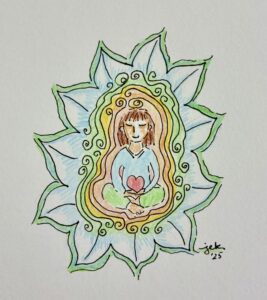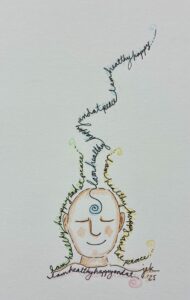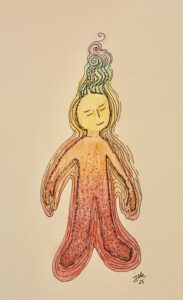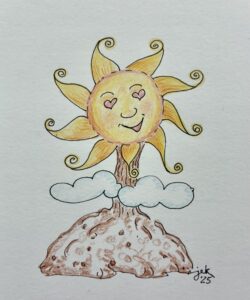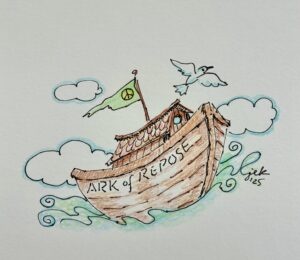
-Artwork © 2025 Jan Ketchel
Introversion can be defined as the quest for divine relationship in the solitude of inner focus. Extraversion is the seeking of that divine communion through connection with energy outside the self. Though most people are dominated by either an innerly or outerly focus, both attitudes and realms of experience are present in some proportion in all individuals.
The genius in Mark Zuckerberg was his intuition of the latent hunger for extraverted connection that Facebook could facilitate. Social media now dominates human energy and human connection. With the development of AI, with its consumption of all human knowledge, we are nearing the projection of divine wisdom and connection onto ChatGPT.
We also live in a time where the ability to infiltrate the divine relationship between the conscious and subconscious minds, within the individual human psyche, through the influencers of political and social media, is commandeering a person’s ability to think for themselves. Mesmerized conscious minds absorb the suggestions flooding from without, which are then materialized by the subconscious through their beliefs, actions and relationships. We become what we absorb.
When our souls project from our physical bodies in our nightly sojourns into the subtler dimensions of life, we are equally confronted with other souls as influencers. The state of our minds as we launch into sleep will largely determine the kinds of encounters we will attract in our dreaming. Like attracts like.
If befuddled or emotionally charged upon entering sleep, one is likely to find oneself in dream milieus that intensify these unsettled states, thus robbing both body and waking mind of the repose and rejuvenation needed to calmly enter and flourish in the new day.
The ancient wisdom to never go to sleep angry is an ark of safety as we navigate the subtler realms of energy in sleep. Equally valuable, in constructing this ark, is the stated intention, as we enter the hypnagogic transfer station from physical to subtle energetic life, to only have interaction with beings committed to our own greater good and the greater good of all. Thus stated, we are primed in our dreaming to receive wisdom and guidance in the calm waters of those at or beyond our level of spiritual development.
This same ark of safety can be constructed as we navigate the flood waters of waking life. First and foremost, we can exercise our will to be healthful in our choice of the amount of time and the type of content we expose ourselves to in the floods of media.
As thoughts are energetic things, which telepathically can enter us, we do well to choose wisely the thoughts we entertain. Thoughts attract like thoughts from without. Attract and absorb only those that promote the greater good of self and other.
As with thoughts, emotions attract like emotions. Strive to be in a steady current of compassion for all life, without judgment, but avoid sympathy that absorbs problem and emotion that is not yours to bear. Send loving support but maintain firm boundaries.
Trust in the divine relationship between conscious and subconscious minds in all beings to solve all challenges. Empowering suggestions, telepathically sent to others, are of invaluable service to their own mastery of life’s energetic floods.
In both the introverted and extraverted playing fields that we enter, the tide waters are quite high. And, though these waters are naturally cyclic, flooding still abounds on all fronts. The divine connection we are drawn to reflects in all worlds, though we must focus according to our predilection. Ultimately, we will discover that all worlds are one.
To construct our ark of safety to navigate all life, the stated intent for the greater good of self and other is sure to deliver us to smooth sailing.
To the greater good of self and other,
Chuck

